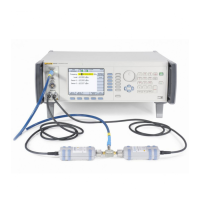Performance Tests
Performance Test 3
3-41
Note
The recommended Power Meter has Power Sensor calibration
factors stored internally in the sensor. Setting the input frequency in
the Power Meter automatically selects the appropriate cal factor for
the measurement. However, the Power Sensor may also be
accompanied by a table of calibration factors which must be applied
externally.
Note
A diode-based Power Sensor may exhibit frequency dependent
linearity errors, and additional corrections for these errors must also
be applied.
11. Allow the Power Meter reading to settle. Record the measured level in dBm
as P
2
for use later in this procedure.
Note
The Power Meter autorange boundary may coincide with a
measurement point. To avoid unwanted Power Meter autoranging,
manually lock the Power Meter range once the 100 kHz reading is
obtained and maintain the Power Meter range lock for all
subsequent frequencies at this amplitude.
12. Set the UUT frequency to the first test frequency listed in Table 3-18.
13. Enter the measurement frequency into the Power Meter and allow the Power
Meter reading to settle. Record the measured level in dBm as P
3
. Calculate
the UUT output P
out
= P
1
+ (P
3
– P
2
).
14. Check that the value of P
out
is within the tolerance shown in Table 3-18.
Note
The insertion loss of the 75 Type-N female-to-female adapter must
be taken into account at each measurement frequency.
15. Set the UUT to the next frequency point listed in Table 3-18 at this amplitude,
and repeat steps 13 through 15.
16. Set the UUT to 100 kHz at the next amplitude listed in Table 3-18, and repeat
steps 10 through 16.
17. Set the UUT output to STBY.

